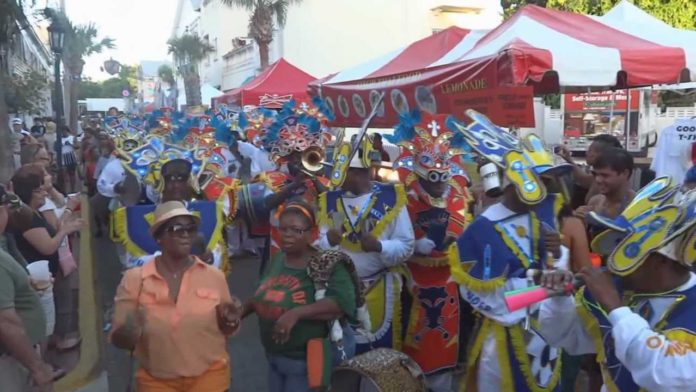Every year, Goombay is a local festival favorite: the smell of beef patties and gumbo in the streets, the sweet, strong tang of rum punch. Families can stroll Petronia Street, their children spilling out onto the sidewalks and lawns, local artisans and vendors displaying colorful art and wares. The festival itself is a happy time, a coming together of the Bahama Village community and the Key West as a whole.
The situation behind the scenes is a different story. The oral history of Key West’s Goombay festival reminds one of a particularly contentious game of telephone. Anyone attending the Feb. 5 City Commission meeting bore witness to the friction between the Key West Carnival Corp. and the Bahama Village Community Coalition, the two factions vying for control of this year’s festival, represented by Veronica Stafford and Glenwood Lopez, respectively.
“It all started with Neighborhood Improvement Association and has been handed down four generations,” said Glenwood Lopez. “We have tried in the past 5 years to give you the best Goombays this community has ever had.” Lopez is a retired educator, administrator, community organizer and chairman of the Bahama Village Community Coalition, which was awarded the festival for another three years in succession at that meeting. “Goombay is an original of the Bahamas, where they have rushing contests each December,” he said. “Goombay is associated with the goombay drums.”
Commissioner Clayton Lopez, Glenwood’s brother, has been integral since the early days of the festival as well, even acting as the sound man in the first festival. Commissioner Lopez issued a statement at the contentious meeting, saying, “In the early 1990s, I worked with KWNIA (Key West Neighborhood Improvement Association), along with one of the leaders of one of the groups vying for it today. During that period I was entertainment director. … I left that position with them because of creative differences in 1995. It became an issue between the current leader of one of the groups before you today and the KWNIA.” He recused himself from the vote on Goombay organizational control, saying, “I said some things to the media that I wish I could take back, not because I don’t believe them to be true, but because they cast a bias on my part as commissioner, and on my integrity.”

Yet Commissioner Lopez speaks fondly of the early days, when the Royal Bahamian Police Band, the Baha Men, and the Gully Roosters headlined under his leadership, hiring “local entertainers almost exclusively around the main act.” He cites the precursor to Goombay as the Island Roots Heritage Festival, a positive effort for neighborhood revitalizations.
“The mayor was Richard Heyman,” Commissioner Lopez said, and “it was to introduce the concept of what would be called Bahama Village.” Indeed, the Island Roots Heritage Festival was a way of “branding” the historically black Bahama Village Community. Bahama Village is a thriving neighborhood that, over the years, has been known variously as “colored town, black town, or Villa Negro.” Lopez recounts the strong economic corridor of Petronia Street — in District 6, which he represents — as home to thriving black-owned businesses pre-segregation.
Segregation pushed more African-American shoppers to Duval Street, and Island Roots was part of the revitalization era. Said Commissioner Lopez: “The Navy pulled out — so late ’60s, early ’70s — and the Duval Street economic boom began. Petronia Street was basically in the middle of all of that; to some of the community leadership’s credit, there was a recognition that something needed to be done to let Bahama Village be a part of this revitalization.” Enter the late ’70s and early ’80s, and the dawn of the crack epidemic, when the Bahama Village neighborhood was hit hard with drug use and decline. That’s around the time the festival actually called “Goombay” first came up.
Other Bahama Village business people, including Richard Hatch, owner of Blue Heaven with partner Suanne Kitchar, point to a slightly different story: the vision of artist and educator Cas Stills, who then owned Blue Heaven with her husband Andy Baxter, as the originators of Goombay.
“We started Goombay as a non-profit,” Baxter said. “Goombay Art Day was what we called it, and we formed a non-profit and Cass was doing art classes for kids.” Baxter sits on the back porch of their Caroline Street home—the couple seems to have a knack for buying great properties at the right time. They bought Blue Heaven in the early ’80s, a time Glenwood Lopez says he was also vying for the property. He and Stills both taught at Frederick Douglass School at the time.
“We roasted a pig in the backyard,” said Baxter, “and the whole neighborhood came and took big plates of the pig and left.” At the time, Baxter and Stills were the rare white business owners on the block. While Petronia Street used to be a largely black commerce corridor, it’s now dominated by non-black business owners, with Blue Heaven the powerhouse at its helm. But back then, the neighborhood was in desperate need of revitalization. The crack epidemic had hit, and Baxter acknowledges it was “kind of a lawless community then.”
Goombay helped unify it, before creating divisions. “At first, it was just an open house at the Blue Heaven,” said Baxter, “But then we said, let’s do it for Fantasy Fest. We had three to four bands, and since we were a non-profit we had a liquor license for that night. The Survivors played; Ben Harrison was one of the first people to play.”
Here, the stories converge. Glenwood Lopez explains that the Neighborhood Improvement Association, headed by Roy Grant, initiated it, and he acknowledges that Stills and Baxter were “on the block, and that’s how they got involved.” This coalition of neighborhood businesses, or some version of it, still runs Goombay today, some 40 years later.
While all of the original parties acknowledge years of contention, they also look back on the festival’s past warmly. “We were just trying to make anything fly, and trying to get people down here,” said Baxter. “We were just trying to get together to clean up that corner.” And they were wildly successful: “that corner” of Petronia and Thomas is booming. Blue Heaven, with Hatch and Kitchar in control, is one of the busiest restaurants on the island. But they no longer control the original non-profit license, which is now under the domain of Glenwood Lopez’s community coalition. These days, Blue Heaven dishes out gumbo and takes a backseat.
The good news? The coalition still functions as a non-profit. “The last four years, we have no debt, and we pay … the police and fire department, the city public works. Our goal is not to make money, just to have the Goombay festival.” In case of overage, Lopez says, they would give money back to the churches and non-profit organizations of the community, but Goombay doesn’t yet have that luxury.
Said Commissioner Lopez: “I think of the cost of the division to the community. … I don’t care who has Goombay as long as the community has a good time.” No matter what is happening behind the scenes, Goombay always manages to deliver on that.
Editor’s note: Veronica Stafford did not respond to the Weekly’s requests for an interview at press time.

























